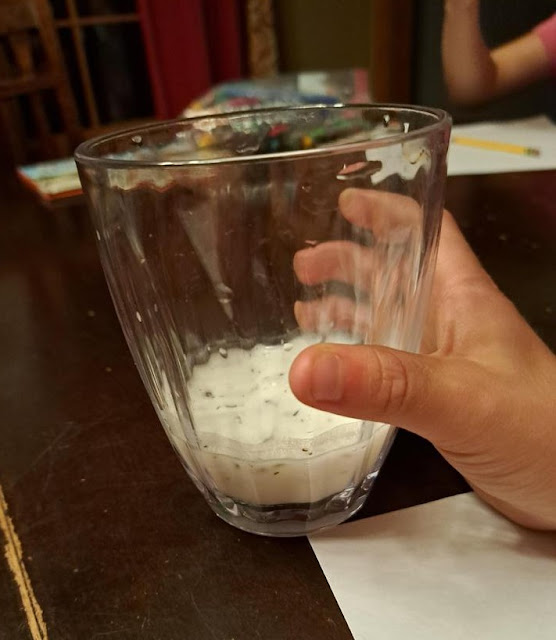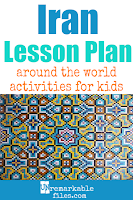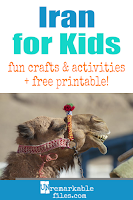Disclaimer: This post contains affiliate links. If you click on them and
buy something, it won't cost you anything extra but I might receive a
sweet commission for referring you.
My kids and I are halfway through The Educational Summer Vacation, which is
what I call learning about different countries in the world while they're on a
break from school. The kids each pick countries they're interested in and we
do our best to learn all about them for a week each, with recipes, crafts,
videos, books, and activities.
This week we learned about Iran. My husband happened to be on a work
trip with a coworker from Iran for part of this week, so he'd text me every
day to ask what we were doing and then fact-check it with his coworker. No
pressure or anything.
Monday
The first thing about Iran you need to know is that it's not pronounced
eye-RAN, but ee-RAHN. It's a Muslim country, but unlike most Muslims in the world which are Sunni,
the majority of Iranian Muslims are Shia. They have a president, but he is
subject to a religious leader called the Supreme Leader.
We watched Iran from the Globe Trekker DVD series and then found Iran on a map of the
world.
(We have a
giant wall map, the
bigger the better.)
In this picture, the kids are filling out their passports. I printed out a bunch of these and made little
booklets with a page for each country we visit.
Download the Passport Pages
The kids drew the flag of Iran (this is the simplified version; the fancier one has a little more detail and some Arabic writing on it.)
The kids thought the crest in the middle looked like the symbol of the Jedi order in Star Wars. You be the judge.
 |
| Jedi symbol photo from Wikimedia Commons |
And then, since the kids are always down for treats, we tried making these Persian walnut cookies from a recipe we found in Your Passport to Iran.
I tasked my 10-year-old with making them as I was going to a dentist appointment, and as I was on the road I got a phone call from her. "Mooooommmmm," she began uncertainly, "I'm concerned about this recipe. There's no flour!"
Yes, they're different from what we normally think of as cookies.
 |
| Why I do not have a baking blog: Exhibit A. |
The pictures that come up when I Google the recipe are much prettier, but everyone ate theirs and Phillip appreciated that it was a naturally gluten-free dessert. Actually, I appreciated that too because modifying foods to make them gluten-free is sometimes a disaster.
We also whipped up some doogh, which is a simple yogurt drink often had in Iran. At first I didn't like it, and then I liked it. It gave you minty fresh breath after drinking it.
 |
| Everyone just got a little glass because, as we'd predicted, it was different enough that none of the kids took more than a few sips. |
Tuesday
My 10-year-old read Count Your Way through Iran out loud to us all and then we learned a little bit about the language in Iran.
In Iran they speak Persian, but it's also known as Farsi. As Phillip's coworker explained to us, the language was originally called "Parsi" after a place called Pars. When the Muslim Conquest of Persia happened in the 7th century, there is no "p" sound in Arabic so the conquerors called it "Farsi."
We watched a video on counting to 10 in Persian, and I mentioned to my teenagers who are learning French in school that there are a lot of French loan words in Persian. To say "thank you" in Persian, you actually say "mersi"!
Written Persian uses the Arabic alphabet, and is written from right to left. There is a beautiful art form in Iran called Persian calligraphy. I showed the kids some examples here and here, and then asked them to create their own.
The younger kids looked at the Arabic alphabet and used letters to make a picture:
Wednesday
You can't talk about Iran without talking about Persian rugs. We watched a video explaining how they're made and then did some weaving of our own.
If your kids are in preschool, you could do a simple woven paper placemat, but since mine are older we went with these woven bookmarks that are so cool.
And I don't think my kids could ever have the patience to make a Persian rug because it's been a week and their bookmarks still look like this:
 |
| They'll make good road trip activities for later this summer, so I'm not pushing it right now. |
As a bedtime story, I read My Grandma and Me by Mina Javaherbin with the kids. It's a really sweet picture book of the author's memories of living with her grandma in Iran when she was little, with a little shout-out to how people of different religions can be really good friends regardless.
For dinner tonight, we had kabab kubideh, an Iranian grilled meat kabob. We used a recipe we found in a library book called We Visit Iran, but you can find several with Google you'd like to try it.
 |
| Looks like we're feeding an army platoon, but it's just our family of 8. |
It was a little salty for me and slightly tedious forming the kabobs, but the kids said they liked them.
Thursday
Iran is such an ancient part of the world. There have been human civilizations here since forever.
We watched a video about Rudkhan Castle, which was built into a hillside in the 3rd century as a military defense and rebuilt again in the 11th century.
Iran is also home to Persepolis, the ceremonial capital of the Achaemenid Empire in the 5th century. We watched a short travelogue on Persepolis and part of a longer video showing the intricate carvings on the stone walls.
My kids liked this video showing what Persepolis might have looked like when it was first built.
Then we looked at pictures of the nearby Naqsh-e Rostam tomb, the resting place of Darius the Great and other kings that was carved into the side of a cliff. Super impressive looking.
One of the inscriptions carved into the rocks is called the DNa inscription, which lists Darius's
great conquests and keeps giving credit to Ahuramazda, the god of Iran's ancient state religion.
Zoroastrianism was one of the first monotheistic religions, focusing on leading a life filled with (1) good works, (2) good thoughts, and (3) good deeds. Freddie Mercury was a Zoroastrian, by the way, which isn't really important here but I thought it was interesting.
I printed out an ancient Zoroastrian symbol called the Faravahar (which you can see carved in a wall at Persepolis) and read to the kids about its symbolism as they colored it in.

The 6-year-old also wanted to cut his out:
 |
| I had to help with some of the detailed cutting and convince him not to try cutting out the inside of the ring in the old man's hand because it would not have ended well. |
You may want to skip this part if your kids are younger and/or easily scared, but there's a site in Iran called the Towers of Silence that my teens and I thought was interesting. Zoroastrians used to lay dead bodies out in the open here because they believed buying them would contaminate the earth. We learned about it in this video.
Friday
Persian New Year, also called Nowruz, is a big deal in Iran. Even though the real Nowruz is in March, we decided to celebrate it today.
Over a dinner of fesenjoon, a walnut and pomegranate stew, we talked about some Norwuz traditions including the Haft Seen table. 'Haft' is Persian for seven and 'seen' is the Persian letter S, so this is literally the '7S table' with 7 symbolic items starting with S laid out in a very Instagrammable way.
 |
| Unfortunately I didn't have pomegranate arils to put on top to make it look nice, but there was pomegranate molasses in it. |
We were planning to have a family bonfire that night in our backyard firepit, because another Nowruz tradition is building bonfires and jumping over them. When telling the kids I was going to leave out the part about jumping over the fires, but Phillip beat me to it.
Phillip was the only one who did (or wanted to do) this, but we supported him. The rest of us had S'mores instead of jumping over the fire.
Other books I gave the kids to read on their own time over the week included:
- Forty Fortunes by Aaron Shepard, an Iranian folk tale
- Pea Boy and Other Stories from Iran
- The Amazing Travels of Ibn Battuta, a picture book adaptation of a 14th century Iranian traveler's manuscripts
- Navid's Story by Andy Glynne, a kids' story about empathy for refugees
This week in Iran, the kids tried a lot of new things, we had some good food, and appreciated another culture that we never would have otherwise this summer. I think we even passed the test of Phillip's coworker, and that's saying something.












No comments:
Post a Comment